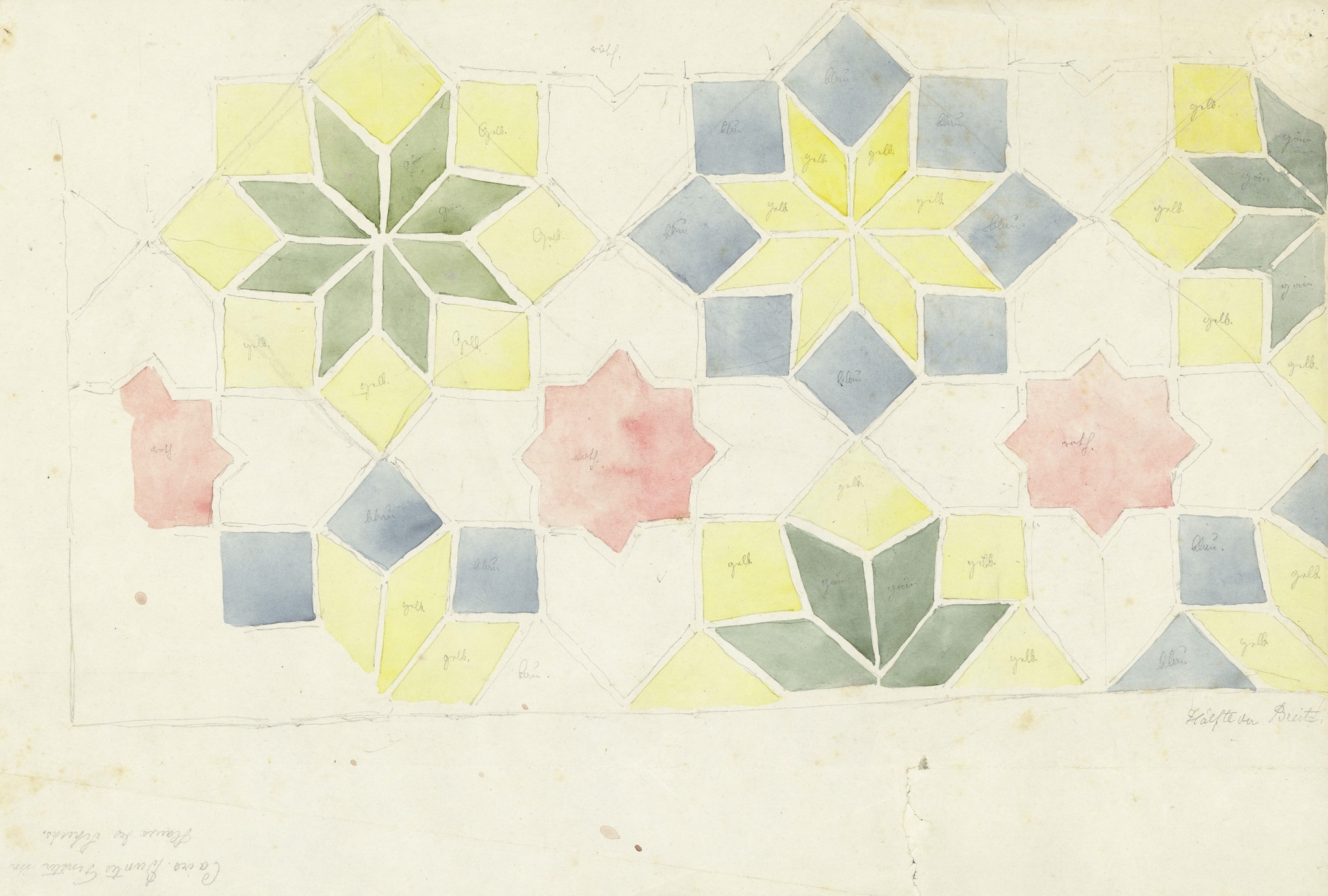The Bernese architect and draughtsman Theodor Zeerleder (1820–1868) executed this pencil and watercolour drawing between January and March 1848. At this time, he was visiting Egypt for the first time, as part of a larger journey through the Ottoman Empire. He stayed in Cairo from 1 January to 26 March 1848. At the end of the following year, Zeerleder made a second journey to Egypt, travelling along the Nile from Cairo to Wadi Halfa and back (Bäbler/Bätschmann, 2006, pp. 57–80 and 128–135; Stiftung Schloss Oberhofen, 2015, p. 8 and 28).
It was Bonaparte’s expedition to Egypt (1798–1801) that paved the way for architects and artists, among others, to take an educational journey to Egypt as part of a so-called ‘Grand Tour’. From the early 19th century, travelling through the Mediterranean became fashionable, and an increasing number of European architects, among them Zeerleder, travelled to the land of the pharaohs to study its Islamic heritage. Both journeys to Egypt contributed to Zeerleder’s formation as an architect, and the drawing presented here bears witness to his intensive study of Islamic architecture, including Cairene stucco and glass windows.
This pencil and watercolour drawing is a study of a Cairene stucco and glass window with star ornaments in blue, yellow, and red: eight-pointed stars are inscribed in slightly larger eight-pointed stars (see also Stiftung Schloss Oberhofen, 2015, p. 38). Three of them combine green and yellow glass, whereas the other three are made of yellow and blue glass. Uncoloured cross-shaped fields with a red eight-pointed star at the centre are set between the eight-pointed stars. Zeerleder has added the colour designations ‘gelb’ (yellow), ‘grün’ (green), ‘blau’ (blue), and ‘roth’ (red) in German for many of the fields that are painted. This could indicate that he coloured parts of the drawing at a later point in time.
According to the longer inscription in the lower left corner of the drawing, which reads ‘Cairo. Buntes Fenster im Hause des Schechs’ (written upside down), the watercolour may depict a window in the ‘House of the Mufti’ in Cairo, so named because it was owned by the Grand Mufti of Egypt, Sheikh Muhammad al-ʿAbbasi al-Mahdi (1827–1897) between 1847 and 1886 (Llewellyn, 1998, p. 154). According to Mercedes Volait, the ‘House of the Mufti’ was built at the beginning of the eighteenth century, between 1704 and 1705 (a date that can be found on a column at the residence) and had been given to Sheikh al-ʿAbbasi when he became Grand Mufti in 1848 (Volait, 2021). In a broader context, the ‘House of the Mufti’ became a popular subject among artists travelling to Egypt during the 19th century. It was also painted, for example, by Frank Dillon (1832–1908) (IG_98, IG_99); František Schmoranz (IG_415); and Franz von Lenbach (Palastinterieur in Kairo, 1876, oil on board, 88 × 70cm, Lenbach-Nachlass im Familienbesitz, reproduced in Baranow, 1986, p. 130). The ‘House of the Mufti’ was also documented in a contemporary photograph by an unknown photographer, in which a stucco and glass window is partially visible on the right-hand side of the picture (IG_476).
In his journal, Zeerleder provided a description of the stucco and glass windows of a private house in Cairo: ‘Die Fenster in dem Mandarah sind an den Enden der Kreuzesarme angebracht u[nd] sind in der Regel 2 übereinander, getrennt durch einen rings um laufenden, vorspringenden Laden, der zum Aufstellen kostbarer Gefässe etc. dient. Die oberen Fenster sind in der Regel von gefärbtem Glas. Sie sind aus Gyps gegossen, u[nd] die gefärbten Glasstücke in den äusseren Rand eingedrückt. Gewöhnlich stellen sie Blumentöpfe, oft auch mathematische Figuren vor u[nd] sind oft sehr geschmackvoll.’ (‘Journal’, Burgerbibliothek Bern, Mss.h.h.XLIV.178, pp. 110–116, cited from Bäbler/Bätschmann 2006, pp. 213–214).
This drawing by Zeerleder is part of a larger corpus of artworks that he made on site in Cairo and which is today held at the Burgerbibliothek Bern in Switzerland. After his return to Switzerland, Zeerleder’s corpus of drawings and watercolours served as a basis for the designs of windows that were to be executed in the traditional European technique with lead cames, but with motifs derived from Cairene stucco and glass windows. In 1854, Count Albert Alexander de Pourtalès (1812–1861) entrusted Zeerleder with the conception and execution of the Selamlik in Oberhofen Castle (Bäbler/Bätschmann, 2006, pp. 168–173; Giese 2016; Giese, 2019; and Keller, 2019), an Arab-style interior with neo-Islamic stained glass windows inspired by colourful Egyptian stucco and glass windows (IG_322–IG_327). The stars represented in this drawing were adopted for the coloured window in Oberhofen Castle, in the same form and colour (IG_323) on the south wall (Keller, 2020, p. 55). Other windows (IG_322, IG_324, IG_325) have ornament similar to that in this drawing, but with variations in form and colour. In windows IG_326, IG_327, and IG_328, the only parallel with this drawing by Zeerleder is the motif of eight-pointed stars inscribed within slightly larger eight-pointed stars.
